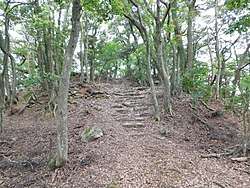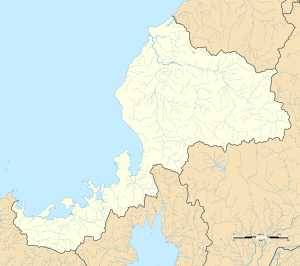Nochiseyama Castle
Nochiseyama Castle (後瀬山城, Nochiseyama-jō) was a Sengoku period yamashiro-style Japanese castle located in what is now part of the city of Obama, Fukui Prefecture in the Hokuriku region of Honshu, Japan. The site has been protected by the central government as a National Historic Site since 1997.[1]
| Nochiseyama Castle 後瀬山城 | |
|---|---|
| Obama, Fukui Prefecture, Japan | |
 site of the Honmaru of Nochiseyama Castle | |
 Nochiseyama Castle 後瀬山城  Nochiseyama Castle 後瀬山城 | |
| Coordinates | 35°29′17.52″N 135°44′20.63″E |
| Type | yamashiro-style Japanese castle |
| Site information | |
| Open to the public | yes |
| Condition | ruins |
| Site history | |
| Built | 1522 |
| Built by | Takeda Motomitsu |
| In use | Muromachi to Sengoku periods |
| Demolished | unknown |
Background
Nochiseyama Castle is located on a 160-meter hill located next to the Tango-kaido highway, at the southeast edge of what is now central Obama city. Obama has prospered as a port Wakasa Bay connecting to Kyoto from before the Heian period.
History
A cadet branch of the Takeda clan from Kai Province gained control of Wakasa Province during the Muromachi Period, but were based in Kyoto and ruled in absentia. The tacked were heavily involved in the politics of the Onin War and were noted supporters of the Ashikaga shogunate. In 1522, Takeda Motomitsu, the fifth generation shugo of Wakasa decided relocate from the war-ravaged Kyoto to his domain and began construction of the castle, which would eventually extend 500 meters from north to south, and would include some 139 kuruwa or baileys , with a palace at the foot of the mountain. The Takeda has close relations with the court nobility and men of arts in Kyoto, and invited many persons of culture to Wakasa as a refuge from the ongoing wars.
However, this interlude was short. By the 1550s there was a major succession dispute within the Takeda clan, during which time the faction let by Takeda Motoaki (1562-1582) sought the assistance of the powerful Asakura clan from neighbouring Echizen Province. Motoaki was installed as the 9th Lord of Wakasa at the head of an Asakura army, and was then taken as a hostage to the Asakura castle of Ichijōdani, and Wakasa was ruled by Asakura proxies.
In 1573, Oda Nobunaga destroyed the Asakura; however, Motoaki was not returned in Wakasa. Instead, Nobunaga's general Niwa Nagahide was awarded the province. Niwa Nagahide was instrumental in the construction of Nobunaga's Azuchi Castle in 1576, and through this experience, greatly expanded upon and improved the defences of Nochiseyama Castle. The central areas at the top of the peak were surrounded by stone walls with huge stones, and a large palace was built at this area. The ramparts of the numerous enclosures on the mountain were also reinforced with stone and with dry moats.
Following Nobunaga's assassination, Niwa Nagahide continued to serve Toyotomi Hideyoshi. However, upon his death, Hideyoshi dispossessed his son and heir, and assigned the castle to Asano Nagamasa (1587-1593) followed by Kinoshita Katsutoshi (1593-1600). After the Battle of Sekigahara in 1600, Kyōgoku Takatsugu was made daimyō of Obama Domain by the Tokugawa shogunate. Within a year, he decided to relocate and construct a new castle, Obama Castle, at the river delta of the Kitagawa and Minamigawa to better control the town and port areas. However, the new castle took so long to construct that he was transferred to Izumo Province before it was finished. Obama Castle was eventually completed by the Sakai clan, and Nochiseyama castle was then abandoned.
Current situation
All of the structures of Nochiseyama Castle have long been lost; however, some of the stone walls of the inner bailey remain at the top of the mountain, which has numerous marked hiking trails.
References
- "後瀬山城". Cultural Heritage Online (in Japanese). Agency for Cultural Affairs. Retrieved 25 December 2016.
External links
| Wikimedia Commons has media related to Nochiseyama Castle. |
- JCastle site
- http://www1.city.obama.fukui.jp/japan_heritage/bunkazai/detail.php?lang=EN Obama city official home page] (in Japanese)